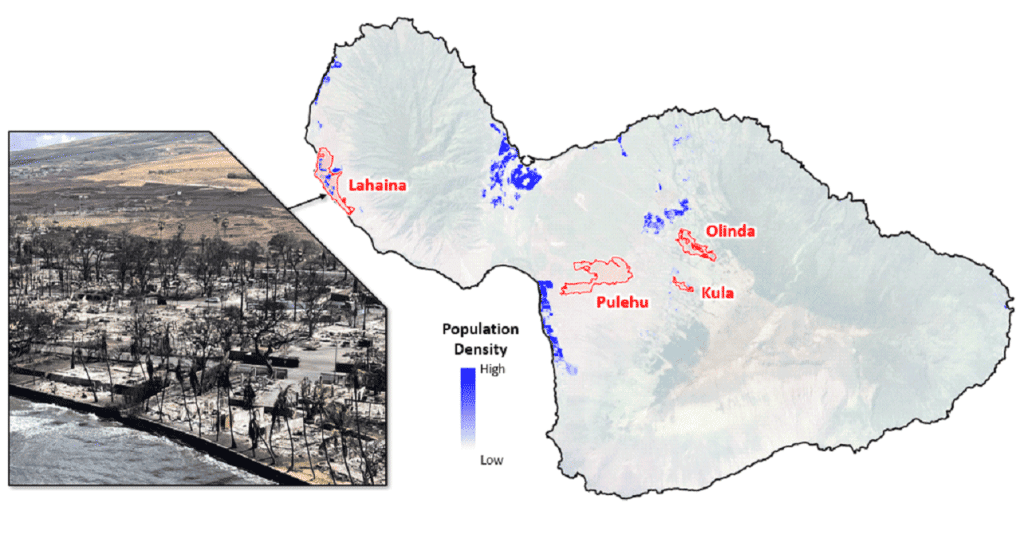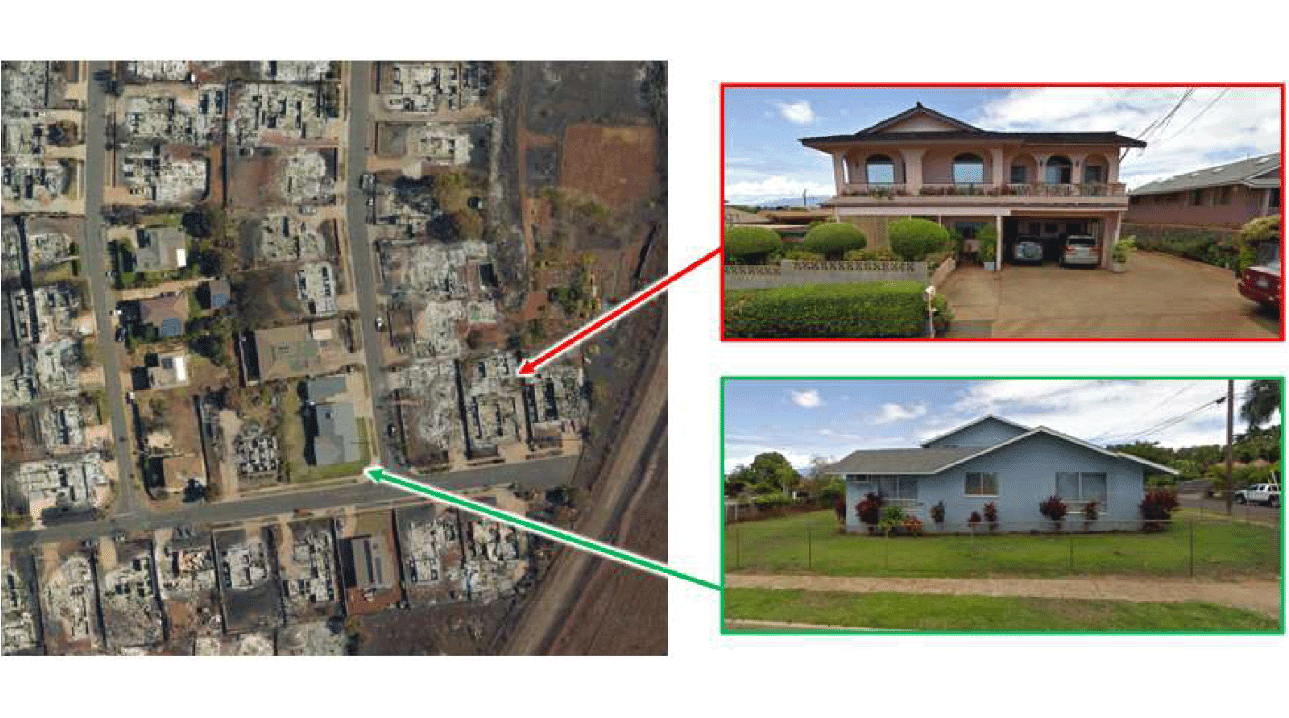The 2023 Maui Wildfires
By TransRe’s Catastrophe Research Team
Executive Summary
In August 2023, a series of wildfires on the Hawaiian island of Maui caused widespread damage and loss of life (Figure 1). The most destructive wildfire struck the historic city of Lahaina, where approximately 81% of the city’s structures were destroyed (FEMA 2023). With a total insured loss of $3.4 billion, the wildfire ranks as Hawaii’s second costliest natural disaster on record behind only Hurricane Iniki in 1992. At least 100 fatalities have been confirmed, making the wildfire the deadliest in the United States in over a century (Insurance Business 2023).

Figure 1 – 2023 Maui Wildfires and impact to Lahain
Several factors contributed to the event’s unprecedented loss of life and property. These loss drivers include:
⦁ Drought conditions dried out vegetation and increased the chance of ignition.
⦁ Flammable surface fuels from invasive grass species provided ample fuel.
⦁ Strong trade winds strengthened by Hurricane Dora sustained the wildfire’s development.
⦁ Downslope winds due to Maui’s mountainous terrain produced strong wind gusts.
⦁ Water shortage limited firefighting efforts to contain and suppress the fire.
⦁ Building stock features typical of Lahaina’s single-family homes helped spread of the fire.
⦁ Changing weather patterns has made Hawaii warmer and drier over recent decades.
Rebuilding Lahaina will likely take years to complete given the scale of destruction. Several obstacles include removal of toxic debris, rezoning to ensure housing affordability, determination of shoreline setbacks, and reconstruction of destroyed infrastructure.
Loss Drivers
Drought Conditions
The rapid drying known as a flash drought (AP 2023) at the start of the summer led to strong drought conditions in August. Nearly a quarter of the island was in a severe drought by the time of the wildfires on August 8 (Figure 2).
Figure 2 – U.S. Drought Monitor from May 23 to August 8, 2023
Flammable Surface Fuels
As the once dominant sugarcane industry has been replaced by tourism, land previously used for plantations has become overwhelmed by invasive grasses (Hawaii Public Radio, 2023). These species tend to spread aggressively during the wet season and dry out rapidly during droughts. These vegetation types common in the outskirts of Lahaina accelerated the spread of the wildfire once ignited (Figure 3).

Figure 3 - Surface fuels surrounding Lahaina, Maui
Strong Trade Winds
Strong Trade Winds
Strong wind is the driver behind many catastrophic wildfires and was critical to the rapid development of the Maui fire (CBS, 2023). The pressure difference between the high-pressure North Pacific High and low-pressure Hurricane Dora passing south of Hawaii intensified trade winds just as the wildfire broke out (Figure 4).
Downslope Winds
Maui’s mountainous terrain helped produce wind gusts up to 70 miles per hour (NBC, 2023). Wind passing over the West Maui Mountains and descending towards Lahaina became warmer, drier, and more intense (Figure 5). This downslope wind phenomenon is equivalent to the Santa Ana winds in California.
Figure 5 – Downslope winds due to Maui’s mountainous topography
Water Shortage
High demand for limited water resources is a longstanding issue in Hawaii. There were several issues with the use of water to suppress the Maui wildfires (Sowby & Porter, 2023):
⦁ Delayed release of water for firefighting: Firefighter requests for water at the outbreak of wildfire were initially denied.
⦁ Power outages inhibited water pumping: Power outages from destroyed utilities or proactive blackouts left firefighters unable to pump water and contain the wildfire.
⦁ Poor prioritization of water resources: Rather than prioritizing suppression of smaller fires before they could intensify, the limited water resources were spent extinguishing already destroyed structures.
⦁ Damaged plumbing depressurized water system: Water supplied for domestic use and fire suppression shared the same plumbing infrastructure. Leaks from damaged pipes in burned buildings depressurized hydrants used for firefighting.
Building Stock
Lahaina’s building stock was dominated by single-family residential construction built between 1960 and 1980 (Figure 6). Several design features typical of these buildings made them susceptible to wildfire (IBHS, 2023):
⦁ Architectural features: Carports and balconies acted as traps that could catch burning embers.
⦁ Open eaves: Roof openings used for ventilation in the warm climate gave embers access to a building’s interior.
⦁ Flammable materials: Wooden decks provided an ample fuel source to sustain new ignitions.
⦁ Building density: The close proximately of buildings (typically less than 20 feet) facilitated fire spread.

Figure 6 – Comparison of destroyed (red) and unaffected (green) building in Lahaina
Changing Weather Patterns
Rising temperatures and declining rainfall has made Hawaii more vulnerable to wildfires (Figure 7). In Maui, the average annual temperature has increased by approximately a degree over the last 50 years. The island’s average annual rainfall has decreased by about 25% over the same period. These trends are projected to continue in the future even under low greenhouse gas emission scenarios (NOAA, 2022).
Obstacles to Rebuilding
Lahaina faces a long road to recovery expected to take years to complete. Several obstacles confront the rebuilding process:
⦁ Hazardous materials: Toxic debris from burned construction and household materials must be removed before reconstruction can begin. Examples of hazardous materials from Lahaina’s typical mid-century homes include asbestos insulation, arsenic treated timber and lead paint (Reuters, 2023).
⦁ Rezoning: Lahaina residents already struggling with rising housing costs face the threat of “climate gentrification” and being priced out of their community’s reconstruction. Maui’s current zoning code will likely be updated to include more multi-family housing to address this affordability issue (PBS, 2023).
⦁ Shoreline setbacks: Maui requires buildings have a minimum shoreline setback to protect against coastal flooding and erosion. Many destroyed coastal structures in Lahaina did not meet this requirement and may no longer be allowed to rebuild unless granted an exception (KHON, 2023).
⦁ Infrastructure: Flaws in Maui’s water and electrical infrastructure will need to be addressed through proactive city planning. This includes improving water resource management, burying electrical lines, and adding more emergency ingress/egress routes (Sowby & Porter, 2023).
March 2024
Please contact Adam Hatzikyriakou, PhD, Research Analyst, with any questions or comments on this topic.
Our Research & Resilience Efforts
We have a diligent and systematic approach to investigating global perils that are impacting various communities at large. Its goal is to discover or revise facts, reach new conclusions, discover new information or achieve new insights that will improve the lives of those impacted by challenging conditions throughout the world.View Research & Resilience



